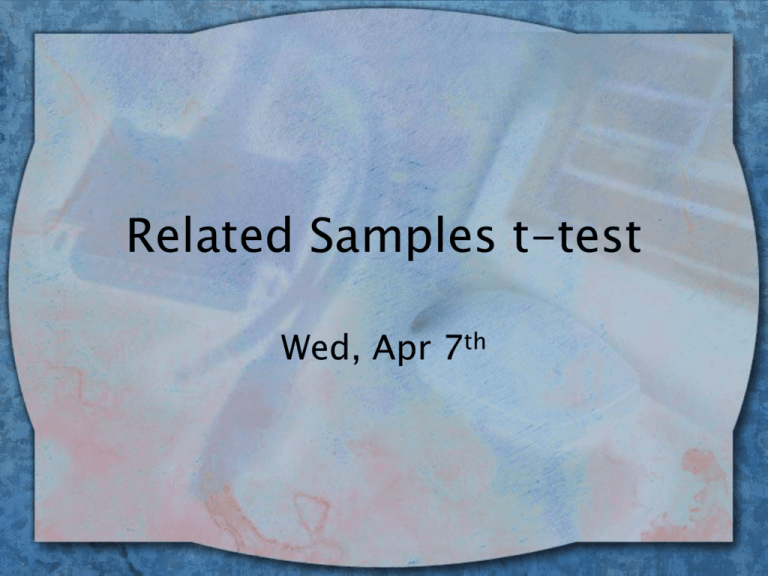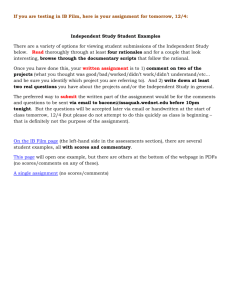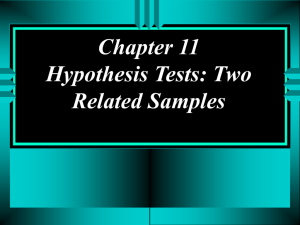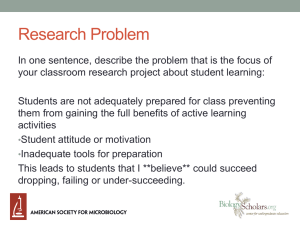Related Samples t-test - the Department of Psychology at Illinois
advertisement

Related Samples t-test Wed, Apr 7th Related Samples t Use when: – 1 group of subjects is tested more than once (e.g., pre-test / post-test)…or – 2 groups of related (or matched) subjects are measured once (e.g., twins) Uses same basic t formula, but focus now on ‘difference’ scores – Differences in pre- and post-test or difference in each partner in a pair Hypotheses Null hyp (Ho) indicates no difference (or no effect), so we’ll hypothesize the mean difference in the pop (D) = 0 Ha indicates there will be a difference (2tailed, D not = 0) or there will be a difference in a specific direction (1-tailed, D > 0 or D < 0). We’ll reject Ho if | t obs | > | t critical| (t observed is in critical region) Ex: What is the effectiveness of a new program to reduce litter? Measured aver litter in 4 cities in ’01 and ‘02 City July 2001 July 2002 Fresno 9 2 Merced 10 4 Bakersfld 8 9 Stockton 9 1 Find D (difference score) for each city, and then the average D (D bar) City D Fresno July July 2001 2002 9 2 Merced 10 4 6 Bakersfld 8 9 -1 Stockton 9 1 8 7 D bar = 20/4 = 5 Next, sum up the deviation scores (D) Then find squared deviation scores for each city (D2) – add a new column Then sum up the squared deviation scores, (D2) Here, D = 20, D2 = 150 Use the T observed formula: T formula for Related Samples Note: D always T observed = (Dbar - D) =0 SDbar Where SDbar (std error) = sqrt (SD2/ N) and SD2 = [D2 – (D)2] / N-1 = 150 – (20)2 / 3 = -83.33 SDbar = sqrt (-83.33 / 4) = -4.56 T obs = (5-0) / -4.56 = -1.09 Finding T critical Use the t table as before, – Need alpha level & 1 or 2-tailed test? – Need Df = N-1 (here N=pairs of scores or total # participants if repeated measures) Ex) use = .01, 1-tailed test (expected litter to decrease), Df= 3 T critical = -4.541 T observed = -1.09 So fail to reject Ho (|t obs| < |t critical|) There is no difference in litter before & after new system not effective SPSS GSS98 dataset example… Analyze Compare Means Paired Samples t-test Pop-up window, select ‘wife…’ for var1, ‘children…’ for var2, then click arrow to put them in “Paired vars” box OK (cont.) In output, 1st section is “Paired Samples Stats”, look for means for ‘wife…” and ‘children’ – this is what we’re comparing In 3rd section, “Paired Samples Test”, note mean difference score, t observed, df, and ‘sig (2-tail)’. – Mean difference score is compared to 0 – Sig (2 tail) should be compared to alpha level (e.g., .05). If ‘sig’ value < alpha reject Null Draw a conclusion about the pre/post test scores.









